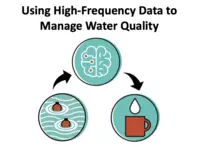Macrosystems EDDIE Modules
Explore the Macrosystems EDDIE modules below. Modules are designed with an A-B-C structure that makes them flexible and adaptable to a range of student levels and course structures. Each module page includes the activity goals, step-by-step instructor guides for implementing the activity, and presentations, handouts and data needed for each activity.
Climate Change Effects on Lake Temperatures
This module was developed by C.C. Carey, S. Aditya, K. Subratie, R. Figueiredo, and K.J. Farrell. Parts of this module were originally developed for the Lake Modeling Moduleas part of the Project EDDIE suite of modules.
Climate change is modifying the thermal structure of lakes around the globe. In this module, students will learn how to use a lake model to explore the effects of altered weather on lakes, and then develop their own climate scenarios to test hypotheses about how lakes may change in the future.
Cross-Scale Interactions
This module was developed by C.C. Carey, and K.J. Farrell.
Phytoplankton blooms emerge through cross-scale interactions between climate and land use drivers across local to continental scales. In this module, students will explore how changes in climate and land use alter lakes, with the goal of predicting how these local and regional drivers will interact to promote or suppress phytoplankton blooms.
Teleconnections
This module was developed by K.J. Farrell and C.C. Carey.
Ecosystems can be influenced via teleconnections, in which meteorological, societal, and/or ecological changes in one region affect climate and associated ecological responses in a distant region. In this module, students will explore how distant drivers interact with local lake characteristics to affect water temperatures and ice cover in different lakes.
Macro-Scale Feedbacks
This module was developed by C.C. Carey, K.J. Farrell, and A.G. Hounshell.
Environmental phenomena, including carbon cycling and greenhouse gas fluxes, are often driven by multiple factors that interact across space and over time. In this module, students "force" a lake model with climate scenarios to test hypotheses about how local and global drivers interact to promote or suppress greenhouse gas fluxes in different lakes.
Introduction to Ecological Forecasting
This module was developed by T.N. Moore, M.E. Lofton, C.C. Carey, and R.Q. Thomas.
Ecological forecasting is an emerging approach which provides an estimate of the future state of an ecological system with uncertainty, allowing society to prepare for changes in important ecosystem services. In this module, students will apply the iterative forecasting cycle to develop an ecological forecast for a National Ecological Observation Network (NEON) site.
Understanding Uncertainty in Ecological Forecasts
This module was developed by T.N. Moore, M.E. Lofton, C.C. Carey, and R.Q. Thomas.
Uncertainty is a crucial part of an ecological forecast, understanding where it comes from, techniques in how it can be measured and ways in which it can be reduced to provide more accurate forecasts. In this module, students will generate an ecological forecast for a NEON site and quantify the different sources of uncertainty within their forecast.
Using Data to Improve Ecological Forecasts
This module was developed by M.E. Lofton, T.N. Moore, C.C. Carey, and R.Q. Thomas.
To be useful for management, ecological forecasts need to be both accurate enough for managers to be able to rely on them for decision-making. To improve forecast accuracy, we can update forecasts with observational data once they become available, a process known as data assimilation. In this module, students will explore how assimilating different types of data at different temporal frequencies (e.g., daily, weekly) affects forecast accuracy.
Using Ecological Forecasts to Guide Decision Making
This module was developed by W.M. Woelmer, R.Q. Thomas, T.N. Moore and C.C. Carey.
Ecological forecasting provides an estimate of the future state of an ecological system with uncertainty. Forecasts must be effectively designed and communicated to those who need them to realize their potential for protecting natural resources. In this module, students will explore real ecological forecast visualizations, identify ways to represent uncertainty, make management decisions using forecast visualizations and learn decision support techniques.
Using High-Frequency Data to Manage Water Quality
This module was developed by M.E. Lofton, R.L. Cooke, and C.C. Carey.
In recent decades, there have been substantial improvements in our ability to monitor water quality in real time using sensors that measure variables at a high frequency (every few minutes). In this module, students will explore data collected using high-frequency sensors and learn how to interpret these data to inform water quality management.
Exploring Tradeoffs in Water Quality Management Using Environmental Data
This module was developed by M.E. Lofton, R.L. Cooke, and C.C. Carey.
Chlorination is an important disinfection step in water treatment, but can sometimes result in the formation of potentially cancer-causing disinfection byproducts. In this module, students will interpret data collected from drinking water reservoirs to inform decision-making about drinking water treatment.
Time Series Modeling and Prediction of Environmental Data
This module was developed by M.E. Lofton, M.R. Hipsey, K. Kurucz, and C.C. Carey.
Advances in environmental sensor technology in recent decades are enabling the collection of environmental data at high temporal frequencies (e.g., every 10 minutes) across many ecosystems. In this module, students will apply several different time series and machine learning models to explore, analyze, and interpret high-frequency environmental data.









